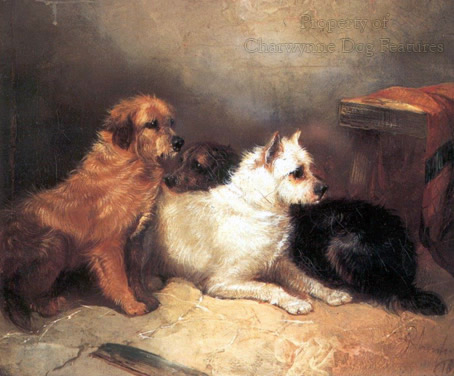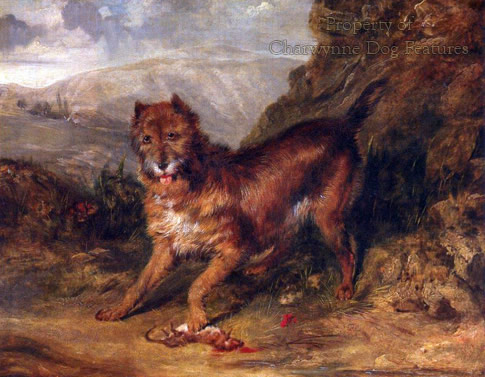805 FITTING OUT THE TERRIER
FITTING OUT THE TERRIER
by David Hancock
 Small all-tan rough-haired terrier darts across your path - is it a Norfolk, a Norwich, a Lucas or none of these? Prick ears means a Norwich, drop ears mean a Norfolk. Does the title truly matter? Are we too quick to put name tags on our terriers? I have judged Lucas Terriers that could have passed muster in the Norfolk rings at Crufts. (Some looked very much like tan Sealyhams too!) For me, the colour of the coat matters less than its texture; how can a terrier perform on a drenching day in December if its skin is soaking wet? Colour of coat seems to matter far too much in so many pedigree breeds. Our ancestors never really cared about appearance provided their terriers could kill vermin - that alone established their value. Did the colour of the coats, or indeed the set of ears and their carriage, ever decide on breeding programmes for working dogs of any type? Are we fitting out these dogs or 'fitting them up'?
Small all-tan rough-haired terrier darts across your path - is it a Norfolk, a Norwich, a Lucas or none of these? Prick ears means a Norwich, drop ears mean a Norfolk. Does the title truly matter? Are we too quick to put name tags on our terriers? I have judged Lucas Terriers that could have passed muster in the Norfolk rings at Crufts. (Some looked very much like tan Sealyhams too!) For me, the colour of the coat matters less than its texture; how can a terrier perform on a drenching day in December if its skin is soaking wet? Colour of coat seems to matter far too much in so many pedigree breeds. Our ancestors never really cared about appearance provided their terriers could kill vermin - that alone established their value. Did the colour of the coats, or indeed the set of ears and their carriage, ever decide on breeding programmes for working dogs of any type? Are we fitting out these dogs or 'fitting them up'? 
In his Hunt and Working Terriers of 1931, Jocelyn Lucas tells of an Aberdeen sportswoman whose three Norwich Terriers killed over 400 rabbits in four years on their own. Only those rabbits picked up were counted, there must have been many more. In his The Sporting Terrier of 1992, Brian Plummer was moved to record: “To watch a small team of Norwich or Norfolk terriers busily working a rat out of a pile of twigs or a rabbit from a patch of rushes is a delight to anyone who has an eye for a good sporting terrier.” Brian also quotes The Norwich Terrier Club Bulletin of 1955 in which, Molly Richardson, a breed enthusiast, wrote: “I suggest we leave the fox and badger to hunt terriers and concentrate on producing a Norwich Terrier who can and will deal with every other sort of vermin that worries a farmer and one who is also the most active, intelligent and charming companion and assistant to the country man and his family.” It’s against that background that I recommended an outcross to the Norfolk to the Sporting Lucas Terrier Club, with the subsequent progeny becoming known as the ‘Hancock’ line. I shall watch their progress with great interest. 
Despite their long local history, the Norwich Terrier, then both prick and drop-eared, was not admitted to the Kennel Club’s register until 1932, with the drop-eared Norfolk variety following suit in 1965; some still insisting that this is one breed, embracing both ear-styles, rather than two, as the KC was persuaded. There should be more to a breed than the set of their ears. Both breeds are favoured at a height of 10 inches at the withers, with a hard, wiry, straight coat lying close to the body, in all shades of red, wheaten, black and tan or grizzle, with small white marks or patches tolerated but undesired. With undocked tails, some look spitz-like when the full-grown tail curls over the back. Currently, the drop-eared Norfolk is much more popular, 500 being registered each year against less than 200 Norwich Terriers.
In the 1950s, before the separate recognition of the drop-eared dogs as Norfolks, there was much discussion in the dog press about the merits of both styles of ear-set, Mrs EH Hardy writing: “…it is a pity that any comparison should be drawn between the prick and our drop-eared Norwich Terriers, as apart from the set of ears (surely a matter to be left to individual preference) the little dogs have the same characteristics and are equally good at work…There is a pack of tiny working terriers in Eire, (top weight 6lbs), used entirely for work and all have prick ears. They were bred from a Norwich and crossed with hunt terriers…” This exchange of views didn’t cover the enhanced hearing associated with prick-eared dogs, so prized by hunters along the Mediterranean shoreline, from Malta to Sicily and Ibiza and right across to Crete.
There have also been occurrences of ‘fluffs’ in some terrier breeds, that is, a soft silky rather luxurious coat, comparable to that of the Soft-coated Wheaten Terrier of Ireland. Fluffs can turn up in the Norwich too, as well as in Welsh Corgis and even German Shepherd Dogs. It may be a freak linked to the tan gene. Coat texture matters a great deal in working terriers, out in all winds and weather. But we do seem to have lost the classic ‘pin-wire’ coat in many breeds intended to be wire-haired. The stiff close coat is so much more a weatherproof jacket, as well as being much easier to manage.
I can see why the erect ear is favoured in a number of breeds; the hunting dogs of the Mediterranean, like the Ibizan and Pharaoh Hounds, hunt by ear as much as sight and scent, with their bat-ears collected every sound emitted from cover. But to restrict a gene pool on colour grounds alone is not wise; the texture of a terrier's coat is the all-important factor - whatever the Breed Standard issued by the Kennel Club lays down! A terrier's coat has to be fit for function.